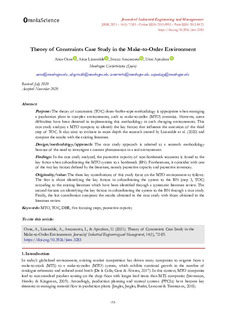Izenburua
Theory of constraints case study in the make to order environmentArgitalpen data
2021Bertsioa
Bertsio argitaratuaDokumentu-mota
ArtikuluaArtikuluaHizkuntza
IngelesaEskubideak
© 2020 by the authors and Journal of Industrial Engineering and ManagementSarbidea
Sarbide irekiaArgitaratzailearen bertsioa
https://doi.org/10.3926/jiem.3283Non argitaratua
Journal of Industrial Engineering and Management Vol. 14. N. 1. Pp. 72-85, 2021Argitaratzailea
Omnia ScienceGako-hitzak
MTO
theory of constraints
DBR
five focusing steps ... [+]
theory of constraints
DBR
five focusing steps ... [+]
MTO
theory of constraints
DBR
five focusing steps
protective capacity [-]
theory of constraints
DBR
five focusing steps
protective capacity [-]
Laburpena
Purpose: The theory of constraints (TOC) drum-buffer-rope methodology is appropriate when managing a production plant in complex environments, such as make-to-order (MTO) scenarios. However, some diff ... [+]
Purpose: The theory of constraints (TOC) drum-buffer-rope methodology is appropriate when managing a production plant in complex environments, such as make-to-order (MTO) scenarios. However, some difficulties have been detected in implementing this methodology in such changing environments. This case study analyses a MTO company to identify the key factors that influence the execution of the third step of TOC. It also aims to evaluate in more depth the research started by Lizarralde et al. (2020) and compare the results with the existing literature.
Design/methodology/approach: The case study approach is selected as a research methodology because of the need to investigate a current phenomenon in a real environment.
Findings: In the case study analysed, the protective capacity of non-bottleneck resources is found to the key factor when subordinating the MTO system to a bottleneck (BN). Furthermore, it coincides with one of the two key factors defined by the literature, namely protective capacity and protective inventory.
Originality/value: The three key contributions of this study focus on the MTO environment as follows.The first is about identifying the key factors in subordinating the system to the BN (step 3, TOC) according to the existing literature which have been identified through a systematic literature review. The second focuses on identifying the key factors in subordinating the system to the BN through a case study. Finally, the last contribution compares the results obtained in the case study with those obtained in the literature review. [-]
Bildumak
Item honek honako baimen-fitxategi hauek dauzka asoziatuta:






















